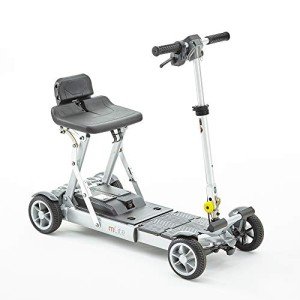Understanding Mobility Devices: Enhancing Independence and Quality of Life
In today's fast-paced world, the desire for mobility is universal. However, specific medical conditions or age-related obstacles can prevent movement, causing an ongoing look for assistance. lightweight mobility scooters serve as necessary tools to boost independence, improve lifestyle, and allow individuals to engage totally in their neighborhoods. This post supplies an extensive introduction of mobility devices, including their types, features, selection requirements, and more.
Kinds Of Mobility Devices
Mobility devices range from easy aids to complicated devices, tailored to fulfill numerous needs. Below is a table summing up typical kinds of mobility devices:
| Type of Device | Description | Ideal For |
|---|---|---|
| Walkers | Four-legged support devices that provide superior stability while walking. | Individuals requiring additional support. |
| Walking sticks | Single or three-legged sticks that enhance balance and assistance walking. | Those with slight mobility troubles. |
| Wheelchairs | Seats mounted on wheels, readily available in handbook and electric variations. | Individuals with minimal or no mobility. |
| Scooters | Electric vehicles developed for outside usage and ease of navigation. | Those who can't stroll cross countries. |
| Crutches | Devices that help people move weight away from an injured leg. | People recuperating from leg injuries. |
| Rollators | Walkers with wheels, seats, and brakes for boosted mobility. | Users requiring rest choices while walking. |
| Lift Chairs | Reclining chairs that help users in standing up and taking a seat. | Seniors or those with mobility restraints. |
| Mobility Scooters | Small electric lorries for restricted mobility, frequently utilized outdoors. | People needing help over long ranges. |
Key Features of Mobility Devices
When selecting a mobility gadget, several key features ought to be thought about to guarantee optimal performance and ease of usage:
- Weight Capacity: Understanding the gadget's weight restriction is essential for security and effectiveness.
- Adjustability: Devices ought to be adjustable in height and width to fit the user conveniently.
- Mobility: Lightweight and foldable alternatives are vital for users who travel or need transport.
- Stability and Safety: Look for features like anti-tip wheels and strong structures to improve security.
- Alleviate of Use: Simple systems and easy to use styles can make a substantial difference in daily usage.
- Comfort: Ergonomic designs and cushioned seats can boost the user experience.
Selecting the Right Mobility Device
Picking the best mobility device can be a complicated job. Here are some actions to direct the decision-making process:
- Assess Needs: Evaluate the individual's mobility challenges and everyday activities.
- Speak with a Professional: Engage health care specialists who can provide recommendations based upon the person's physical condition.
- Trial Options: If possible, trial various devices to figure out convenience and functionality.
- Evaluation Budget: Consider the cost of the gadget, including any additional features or modifications required.
- Research study Options: Determine the very best brands and models by checking out reviews and contrasts.
Table: Comparative Analysis of Popular Mobility Devices
| Device | Benefits | Drawbacks |
|---|---|---|
| Walkers | Outstanding stability, promotes walking. | Large, may restrict movement in small areas. |
| Walking sticks | Lightweight, improves balance. | May not provide enough assistance for extreme mobility concerns. |
| Wheelchairs | Suitable for those with significant mobility restrictions. | Can be cumbersome, especially in indoor environments. |
| Scooters | Great for outdoor use, easy to maneuver. | Restricted indoor functionality, heavier. |
| Rollators | Supplies rest choice, easy to move. | May need more area than conventional walkers. |
| Lift Chairs | Comfy, helps shift from sitting to standing. | More expensive, bigger footprint. |
Often Asked Questions (FAQs)
1. What is a mobility gadget?
A mobility device is any tool created to help individuals in moving and navigating their environment. This includes walkers, wheelchairs, scooters, and crutches.
2. How do I understand which mobility gadget is best for me?
Consider your specific mobility challenges, physical capabilities, and lifestyle requirements. Consulting with health care specialists can also provide customized recommendations.
3. Are mobility devices covered by insurance?
Many insurance strategies, consisting of Medicare, might cover certain mobility devices. It's important to contact your insurance coverage service provider for specific coverage information.
4. Can I rent a mobility device rather of buying one?
Yes, numerous medical supply stores and drug stores provide rentals for mobility devices. This option is helpful for individuals with short-lived mobility issues.
5. How can I preserve my mobility device?
Routine maintenance is crucial. It consists of cleaning up the gadget, looking for wear and tear, and making sure all parts are working correctly.
The Impact of Mobility Devices on Quality of Life
Mobility devices significantly improve the lifestyle for individuals with minimal mobility. They cultivate independence, motivate social interaction, and improve access to necessary services and leisure activities.
- Increased Independence: Users can navigate their neighborhoods, participate in occasions, and participate in hobbies without counting on others.
- Social Engagement: Mobility devices assist in participation in social events, therefore combating feelings of isolation.
- Boosted Safety: Devices supply stability and lower the danger of falls, promoting user confidence.
Mobility devices are more than just tools for motion; they are gateways to self-reliance and quality living. By comprehending the various kinds of mobility aids readily available, their key functions, and considerations for selecting the best gadget, people can make informed decisions about their mobility needs. Ultimately, the right mobility gadget can result in a more active, fulfilling life. Whether it's a walker, wheelchair, or scooter, the best choice contributes considerably to improving the mobility and independence of users.

